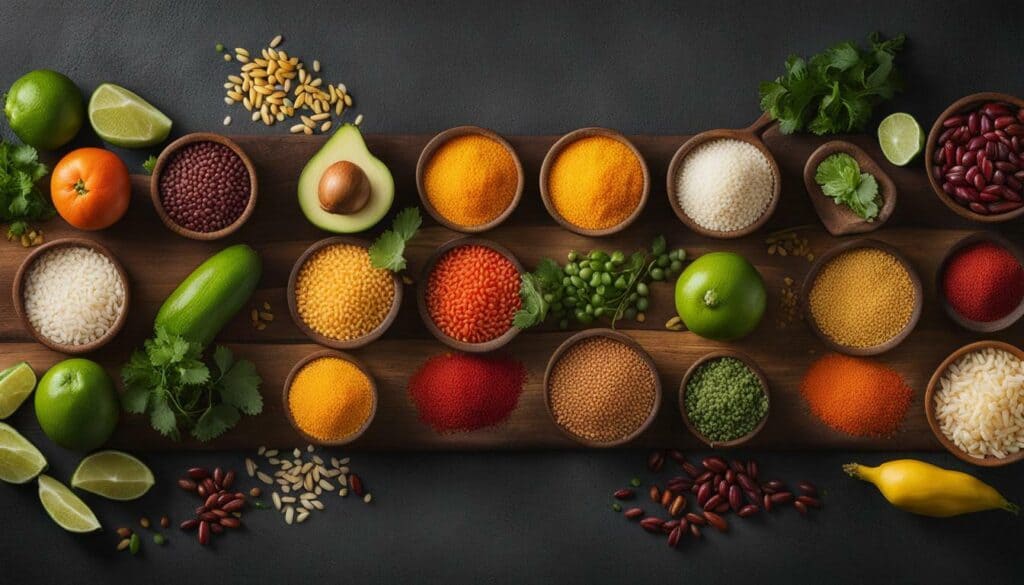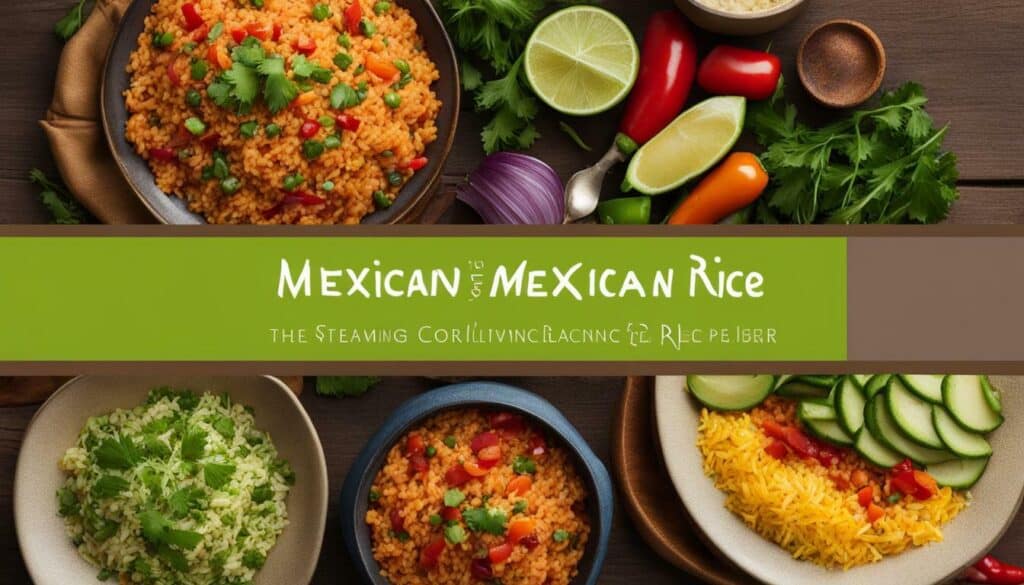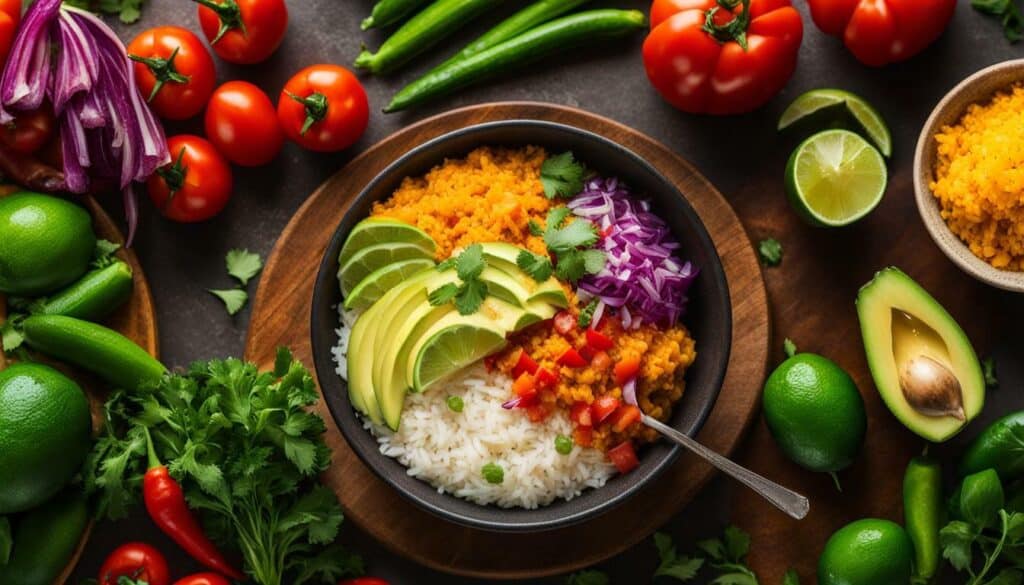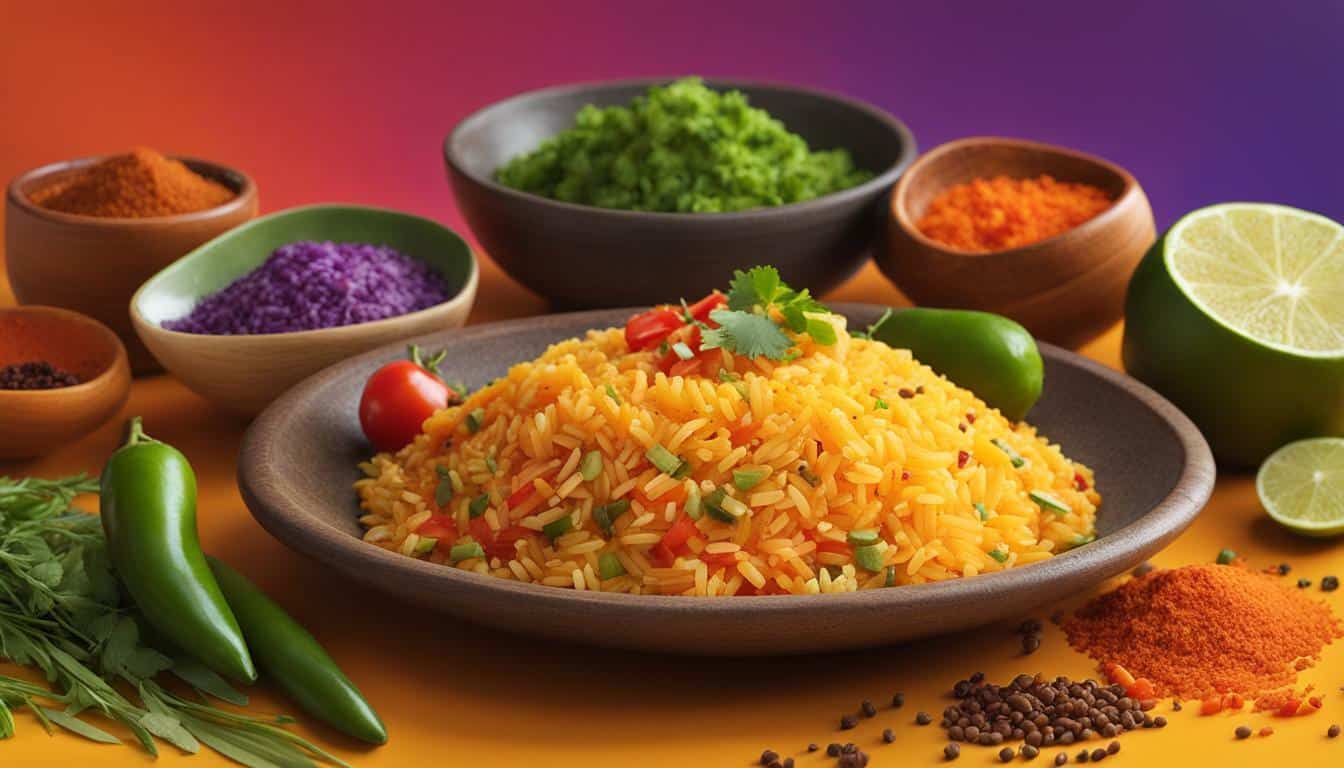Mexican rice is a beloved side dish in Mexican cuisine, but have you ever wondered about its nutritional content? Understanding the nutritional value of this flavorful and nutrient-dense dish can help you make informed choices about your diet. Let’s uncover the Mexican rice nutrition facts you need to know.
- Mexican rice contains approximately 300 calories per cup.
- It is rich in vitamins, minerals, and fiber, making it a nutritious addition to your meal.
- Incorporating protein-rich foods is important when consuming Mexican rice to ensure a balanced meal.
- Mexican rice can be enjoyed as part of a healthy diet when consumed in moderation and paired with regular exercise.
- Choosing healthier rice options such as brown rice or quinoa can help reduce calorie intake while enjoying Mexican rice.
The Ingredients and Preparation of Mexican Rice
Mexican rice is typically made with a combination of flavorful ingredients, including white rice, chicken stock, tomatoes, garlic, onion, oregano, and a drizzle of olive oil. These ingredients come together to create a delicious and aromatic dish that pairs perfectly with Mexican cuisine. The preparation of Mexican rice involves sautéing the rice in oil until it turns golden brown. Then, chicken stock, tomatoes, garlic, onion, and oregano are added to the pot, infusing the rice with a rich and savory flavor. The dish is simmered until the rice is cooked through and absorbs all the delicious flavors.
To prepare Mexican rice, start by heating a drizzle of olive oil in a large pot over medium heat. Add the rice and sauté until it turns golden brown, stirring occasionally to prevent it from burning. Next, add the chicken stock, tomatoes, garlic, onion, and oregano to the pot. Stir well to combine all the ingredients. Bring the mixture to a boil, then reduce the heat to low and cover the pot. Allow the rice to simmer for about 20 minutes, or until the rice is tender and has absorbed all the liquid. Fluff the rice with a fork before serving to ensure it is light and fluffy. Mexican rice is a versatile side dish that can be enjoyed with a variety of main courses or used as a filling for burritos and tacos.
| Ingredients: | Quantity: |
|---|---|
| White rice | 1 cup |
| Chicken stock | 2 cups |
| Tomatoes (diced) | 1 cup |
| Garlic (minced) | 2 cloves |
| Onion (diced) | 1/2 cup |
| Oregano | 1 teaspoon |
| Olive oil | 2 tablespoons |
“Mexican rice is a versatile side dish that can be enjoyed with a variety of main courses or used as a filling for burritos and tacos.”

Incorporating Mexican rice into your meals adds a burst of flavor and a touch of authenticity to your dining experience. With its simple yet vibrant ingredients and easy preparation, it’s no wonder why Mexican rice is a staple in many households. So, whether you’re hosting a Mexican-inspired dinner party or simply craving a taste of the vibrant cuisine, give this delicious side dish a try!
Mexican Rice Nutrition Facts and Calorie Content
When it comes to its nutrition facts, Mexican rice contains approximately 300 calories per cup. This flavorful side dish is not only delicious but also packed with essential vitamins, minerals, and fiber. Made with ingredients like white rice, chicken stock, tomatoes, garlic, onion, oregano, and olive oil, Mexican rice offers a range of nutrients that contribute to a well-balanced diet.
Here is a breakdown of the key vitamins and minerals found in Mexican rice:
| Nutrient | Amount per cup |
|---|---|
| Vitamin C | 8.7mg |
| Vitamin A | 609IU |
| Potassium | 160mg |
| Iron | 1.1mg |
In addition to these vitamins and minerals, Mexican rice also provides a good amount of dietary fiber. Fiber is essential for maintaining a healthy digestive system and can help regulate blood sugar levels.
It’s important to note that the calorie content of Mexican rice can be part of a healthy diet as long as it is consumed in moderation and balanced with regular exercise. For those looking to reduce calorie intake, choosing healthier rice options such as brown rice or quinoa can be a great alternative. These options offer more fiber and nutrients compared to white rice.
Remember, Mexican rice can be a delicious and nutritious addition to your meals. Just be mindful of portion sizes and make healthier choices whenever possible. By incorporating balanced meals and physical activity into your routine, you can enjoy this flavorful dish while maintaining a healthy lifestyle.

Mexican rice is not just delicious, but it also packs a nutritional punch, providing essential vitamins, minerals, and fiber. This flavorful side dish is made with white rice, chicken stock, tomatoes, garlic, onion, oregano, and olive oil, making it a nutritious addition to any meal. Let’s take a closer look at the key nutritional components of Mexican rice.
One serving of Mexican rice, approximately one cup, contains an average of 300 calories. While it may be higher in calories compared to some other side dishes, the nutritional value it offers makes it worth considering. Mexican rice is a good source of vitamins such as vitamin C, which supports a healthy immune system, and vitamin A, which promotes good vision and skin health.
In addition to vitamins, Mexican rice also provides essential minerals like potassium, magnesium, and iron. Potassium is important for maintaining healthy blood pressure levels, while magnesium is essential for bone health and overall well-being. Iron is crucial for carrying oxygen throughout the body and preventing anemia.
Furthermore, Mexican rice is high in dietary fiber, which aids in digestion, promotes satiety, and helps regulate blood sugar levels. Fiber also supports heart health by reducing cholesterol levels. By incorporating Mexican rice into your diet, you can enjoy a delicious dish while reaping the benefits of these important vitamins, minerals, and fiber.

| Nutrient | Amount per Serving (1 cup) |
|---|---|
| Calories | 300 |
| Vitamin C | 15% of Daily Value (DV) |
| Vitamin A | 10% of DV |
| Potassium | 8% of DV |
| Magnesium | 6% of DV |
| Iron | 4% of DV |
| Fiber | 2g |
Incorporating Protein for a Balanced Meal
To ensure a balanced meal, it is crucial to incorporate protein-rich foods when enjoying Mexican rice. This will not only enhance the nutritional value of your meal but also provide you with the essential amino acids your body needs for growth and repair.
Protein options that pair well with Mexican rice include grilled chicken, lean beef, black beans, or tofu. These ingredients not only add flavor and texture but also contribute to a more satisfying and filling meal.

For those following a plant-based or vegetarian diet, adding sources of plant-based protein such as quinoa, chickpeas, or lentils can also be a great way to enhance the nutritional profile of your Mexican rice dish.
By combining protein-rich foods with Mexican rice, you can create a well-balanced meal that provides a good balance of carbohydrates, protein, and healthy fats. This will help keep you feeling full and satisfied while also supporting your overall health and well-being.
| Protein Options for Mexican Rice: |
|---|
| Grilled chicken |
| Lean beef |
| Black beans |
| Tofu |
| Quinoa |
| Chickpeas |
| Lentils |
Healthy Choices for Mexican Rice
If you’re looking to make healthier choices while enjoying Mexican rice, there are several options to consider, such as low-calorie variations and gluten-free alternatives. Mexican red rice is a flavorful and nutrient-dense side dish commonly served with Mexican cuisine. It contains around 300 calories per cup and is rich in vitamins, minerals, and fiber. However, by making a few simple substitutions, you can reduce the calorie content and make it even more nutritious.
One option is to swap out the white rice typically used in Mexican rice recipes for brown rice. Brown rice is a whole grain that retains its bran and germ, making it higher in fiber and nutrients compared to white rice. It has a nutty flavor and a slightly chewy texture, adding a delicious twist to your Mexican rice. Brown rice is also a gluten-free alternative for those with gluten sensitivities or following a gluten-free diet.
Another healthy choice is to substitute quinoa for white rice. Quinoa is a complete protein that contains all nine essential amino acids, making it an excellent option for vegetarians and vegans. It is also high in fiber and packed with vitamins and minerals. Quinoa has a light, fluffy texture and a mild, nutty flavor that pairs well with the traditional Mexican rice ingredients.
To further boost the nutritional value of your Mexican rice, consider adding colorful vegetables like bell peppers, corn, and peas. These vegetables provide additional vitamins, minerals, and fiber while adding vibrant colors and flavors to your dish. You can also incorporate lean protein sources like grilled chicken, shrimp, or beans to create a well-rounded and satisfying meal.

Remember, moderation is key when it comes to enjoying Mexican rice. While it can be a nutritious and delicious addition to your diet, it’s important to be mindful of portion sizes and balance it with other healthy food choices. Pairing your Mexican rice with regular exercise can also help maintain a healthy lifestyle. So, next time you indulge in this flavorful dish, make sure to make the healthier choices that best suit your nutritional needs and preferences.
Mexican Rice for Weight Loss or Management
Despite its calorie content, Mexican rice can still be part of a weight loss or weight management program when consumed mindfully and paired with a balanced diet. Mexican red rice is a flavorful and nutrient-dense side dish commonly served with Mexican cuisine. While it contains around 300 calories per cup, it is also rich in vitamins, minerals, and fiber, making it a nutritious choice.
To incorporate Mexican rice into a weight loss or weight management program, portion control is key. By monitoring serving sizes and practicing mindful eating, you can enjoy this delicious dish while still maintaining your calorie goals. Consider pairing Mexican rice with protein-rich foods such as grilled chicken, lean beef, or black beans to create a well-rounded and satisfying meal.
Additionally, choosing healthier rice options can further support your weight loss or weight management efforts. Opting for brown rice or quinoa instead of white rice can reduce the calorie intake while providing more fiber and nutrients. These alternatives have a lower glycemic index, which means they are digested more slowly, helping to keep you feeling fuller for longer.
It’s important to note that Mexican rice alone is not a magic solution for weight loss. It should be part of a comprehensive approach that includes a balanced diet, regular exercise, and overall healthy lifestyle habits. By incorporating portion control, nutritious ingredients, and physical activity, you can enjoy Mexican rice as a delicious addition to your weight management journey.
| Nutrient | Amount per cup (cooked) |
|---|---|
| Calories | Approximately 300 |
| Protein | 6 grams |
| Fat | 5 grams |
| Carbohydrates | 54 grams |
| Fiber | 2 grams |
| Vitamin A | 4% of the Daily Value (DV) |
| Vitamin C | 2% of the DV |
| Iron | 6% of the DV |
Despite its calorie content, Mexican rice can be enjoyed as part of a balanced diet. By practicing portion control, incorporating protein-rich foods, and making healthier rice choices, you can savor the flavors of this traditional dish while still working towards your weight loss or weight management goals. Remember, moderation and mindful eating are key to maintaining a healthy lifestyle.

To enjoy the benefits of Mexican rice without consuming excessive calories, it’s essential to practice moderation and incorporate regular exercise into your routine. While Mexican rice is a flavorful and nutrient-dense side dish, it can contribute to weight gain if consumed in large quantities or paired with high-calorie foods. By adopting a balanced approach, you can savor the delicious flavors of Mexican rice while maintaining a healthy lifestyle.
One way to practice moderation is by controlling portion sizes. Instead of indulging in heaping servings of Mexican rice, opt for a sensible portion that aligns with your individual caloric needs. By being mindful of your serving size, you can enjoy the flavors without overindulging.
Pairing Mexican rice with protein-rich foods is another key aspect of moderation. Incorporating lean proteins like grilled chicken, shrimp, or beans into your meal can help create a well-rounded and satisfying dish. Protein not only provides essential nutrients, but it also helps to promote satiety and regulate appetite, making it easier to manage your portion sizes.
| Nutritional Content of Mexican Rice | Per 1 cup serving |
|---|---|
| Calories | Approximately 300 |
| Protein | 6 grams |
| Fat | 6 grams |
| Carbohydrates | 54 grams |
| Fiber | 3 grams |
Regular exercise is also crucial for maintaining a healthy lifestyle. Incorporating physical activity into your routine can help burn calories, improve cardiovascular health, and boost overall well-being. Aim for at least 150 minutes of moderate-intensity exercise, such as brisk walking or cycling, each week. Additionally, including strength training exercises in your routine can help build lean muscle mass and increase your metabolism.
By practicing moderation and incorporating regular exercise into your lifestyle, you can enjoy the flavors of Mexican rice while supporting your overall health and wellness goals. Remember to listen to your body’s hunger and fullness cues, make conscious choices, and savor each bite. Together, these habits will contribute to a balanced and fulfilling approach to food.

- Practice moderation by controlling your portion sizes when enjoying Mexican rice.
- Pair Mexican rice with protein-rich foods to create a well-rounded meal.
- Incorporate regular exercise into your routine to promote overall health and weight management.
Conclusion
Exploring the nutrition facts of Mexican rice reveals its potential health benefits and provides insights into making healthier choices while enjoying this flavorful side dish. Mexican red rice is a flavorful and nutrient-dense side dish commonly served with Mexican cuisine. It contains around 300 calories per cup and is rich in vitamins, minerals, and fiber.
Mexican rice is typically made with white rice, chicken stock, tomatoes, garlic, onion, oregano, and olive oil. To ensure a balanced meal, it is important to incorporate protein-rich foods when consuming Mexican rice. By pairing it with lean proteins such as grilled chicken or beans, you can create a satisfying and well-rounded dish.
While the calorie content of Mexican rice can be a part of a healthy diet, moderation is key. It is advisable to monitor portion sizes and balance macronutrient intake. Additionally, choosing healthier rice options like brown rice or quinoa can help reduce calorie intake and provide added nutritional benefits.
If you are looking to include Mexican rice in a weight loss or weight management program, portion control and mindful eating are essential. By being mindful of portion sizes and balancing your overall calorie intake, Mexican rice can be enjoyed as part of a healthy eating plan. And don’t forget to incorporate regular exercise into your routine to support overall health and well-being.
FAQ
Q: What is the nutritional value of Mexican red rice?
A: Mexican red rice is a nutrient-dense side dish that contains around 300 calories per cup. It is rich in vitamins, minerals, and fiber, making it a healthy choice for your meals.
Q: What are the ingredients used in Mexican rice?
A: Mexican rice is typically made with white rice, chicken stock, tomatoes, garlic, onion, oregano, and olive oil. These ingredients combine to create a flavorful and aromatic dish.
Q: Can Mexican rice be a part of a healthy diet?
A: Yes, Mexican rice can be a part of a healthy diet as long as it is consumed in moderation and paired with protein-rich foods. It is also recommended to choose healthier rice options such as brown rice or quinoa to reduce calorie intake.
Q: How can Mexican rice be included in a weight loss or weight management program?
A: Mexican rice can be included in a weight loss or weight management program by monitoring portion sizes and balancing macronutrient intake. It is important to be mindful of your overall calorie intake and incorporate regular exercise into your routine.
Q: Are there healthier choices for Mexican rice?
A: Yes, there are healthier choices for Mexican rice. You can opt for low-calorie variations, use healthier ingredients, and consider gluten-free options. Brown rice or quinoa can also be used as healthier alternatives.
Q: What should I be cautious of when consuming Mexican rice?
A: When consuming Mexican rice, it is important to avoid excessive calorie consumption by making healthier choices and watching portion sizes. It is also recommended to incorporate physical activity into your routine for a balanced and healthy lifestyle.
What Are the Nutrition Facts for Spaghetti Meat Sauce Compared to Mexican Rice?
When comparing spaghetti meat sauce nutrition facts to Mexican rice, it’s important to note that each dish has its own unique nutritional profile. Spaghetti meat sauce generally contains a good amount of protein, vitamins, and minerals, depending on the meat used. Mexican rice, on the other hand, tends to be higher in carbohydrates and fiber due to the rice and added vegetables. Both dishes can be part of a balanced diet, but it’s essential to adjust portion sizes according to individual dietary needs.





Leave a Reply